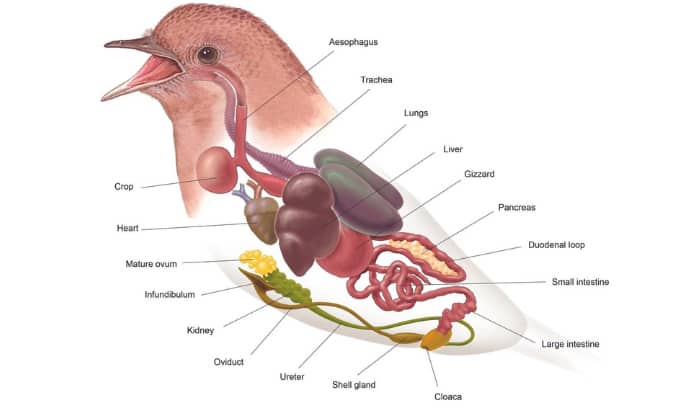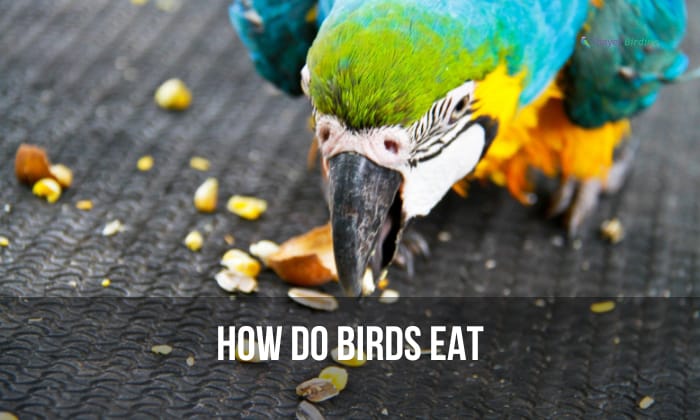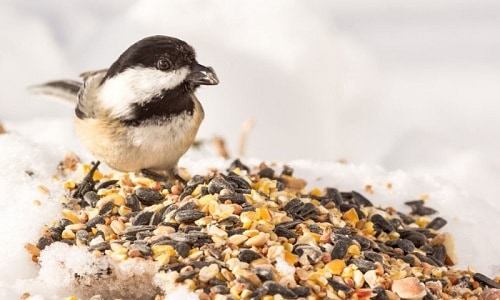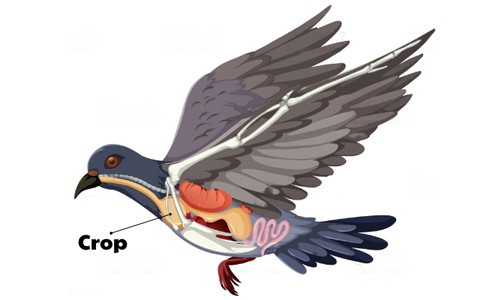Birds are almost always seen pecking at the ground foraging for seeds and nuts, but what happens after they find their food? How do birds eat?
Birds digest food slightly differently than we do, mainly because they don’t have teeth and swallow their food whole or in smaller chunks. Thankfully, they have particular organs designed to “chew” their food.
Read on to learn all about the different parts of a bird’s digestive system–and why they sometimes eat rocks!
Table of Contents
Understanding Bird Digestion
It takes a lot of energy to survive in the wild, let alone fly. If you factor in birds’ tiny bodies and stomachs, you’ll understand why they seem to spend all their time foraging for food!
However, finding food is only the first step of many, the real magic happens once the food enters a bird’s digestive tract. The process of digesting food in avians is an intricate and captivating tale of adaptation and survival.
Steps Involved in Bird Digestion

How do birds digest their food and turn insects and seeds into flight fuel?
Step 1: Chewing and Swallowing
Chewing and swallowing are tricky in the absence of teeth. Birds typically eat either eat by
- Ripping or shredding soft food such as fruit or prey;
- Breaking open seeds and nuts with their bills;
- Smashing nuts, seeds, and other hard food (such as crustaceans) against rocks; or
- Simply swallowing smaller-sized food whole;
Once in their mouths, birds use their tongues to help position the food properly to make them easier to swallow.
Some birds produce saliva that helps the food slide down their throats quicker by binding the little bits together and making it more slippery.
Step 2: The Trip Down Esophagus Lane
After swallowing, the food travels down the bird’s esophagus. Some birds have expandable esophagi to store food, but others have a particular area called the crop which also serves the same purpose.
When it’s time to consume the food, it travels through the bird’s digestive tract to the proventriculus, where digestive enzymes soften it.
The food will then move to the gizzard, an organ with strong muscles that grind and crush the food. This specialized stomach is actually how birds chew their food without teeth!
At this point, the food can return to the proventriculus and go through the cycle again.
Once the food has been sufficiently processed, it proceeds to the small and large intestines, which absorb the available nutrients and water with the help of the liver, pancreas, and ceca.
Step 3: Eliminating Waste
There is usually some waste left after food passes through the entire digestive system of birds, from small bones to feathers and other inorganic materials. Birds eliminate these waste materials in one of two ways.
Waste can be excreted as feces which exits through birds’ cloaca. However, it can also be regurgitated through their bills as little pellets.
Bird Anatomy for Feeding
Birds did not evolve into different shapes and sizes randomly. Instead, these were all intentional evolutions to help birds adjust to their specific habitats.
Another advantage of looking and eating differently from one another is the lessening of competition. Can you imagine what would happen if all birds were fighting over the world’s insects?
One of the biggest signs of where a bird lives and what it eats is the size and shape of its bill.
1. Bird beaks adaptations for feeding
Bird beaks are strong but light. They aren’t made of bone–they are made out of keratin, which is the same protein our fingernails are made out of.
After all, birds can’t carry too much weight as they take to the skies.
There are generally three different shapes of bills that correspond to three diets:
- Long, straight, pointy bills belong to fish-eating birds. This bill shape makes it easy for them to skewer fish and grasp them properly.
- Short, broad, flat bills that can open widely belong to insect eaters. This bill helps them snatch insects in mid-air.
- Conical, short, sharp bills typically belong to seed-eaters. This shape allows them to crack open seeds easily.
However, remember that most birds are omnivores that eat a varied diet. Their bill shape is simply a clue as to what they usually eat.
2. What’s A Crop?
The crop is found in certain animals’ lower esophagus, particularly some birds, insects, snails, and worms.
Primarily, the crop is a place for animals to store food, whether for personal consumption or to regurgitate for their young later.
Some species, such as doves and pigeons, produce “crop milk,” which they feed their chicks.
3. What’s The Gizzard For?
The gizzard is sometimes called the “muscular stomach.” As its nickname suggests, the muscle-lined organ grinds and “chews” food for certain animals that can’t.
However, sometimes even the gizzard needs help mashing up food. To make it easier on their muscular stomachs, some birds eat tiny stones or gravel that internally rub against the food to crush them. These are known as “gizzard stones.”
The organ’s muscles are protected by a special membrane made of a protein known as “koilin”.
Frequently Asked Questions
What’s the difference between a beak and a bill?
According to the Cornell Lab of Ornithology, there is no difference–the words can be used interchangeably.
Though, there is a practice of “beaks” referring to birds with sharp bills and “bills” referring to wider, flatter, fleshy beaks.
Do birds use their feet to eat?
Yes! Birds first use their feet to get food by scratching the ground or carrying their prey home.
Come eating time, some birds are known to use their feet to keep a firm grip on their food while ripping or breaking it open.
Conclusion
Now that you know how do birds eat, the parts of their digestive system, and the importance of the shape of their beaks, we hope you appreciate the marvel of nature and evolution more.
Birds may not have teeth in their mouths, but they have particular bills custom-made for their preferred diet and habitat and gizzards that grind their food on the inside.
Humans, unfortunately, don’t have this organ. So the next time you are having a meal, use your pearly whites and chew properly!

George and I became friends after a birdwatching trip with our new group. And we have been enjoying every adventure together. When he told me the idea of establishing a site that shares our experiences and fun, I immediately agreed. After trials and errors, here we have Thayerbirding.





















